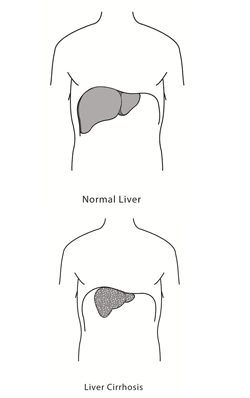
Function of liver
Liver is one of most important organs of the body and it performs several vital functions. Two such important functions are production of several important substances in the body like the clotting factors (these are the factors which help in blood clotting) and takes part in the metabolism of different endogenous (produced in the body) like glucose and exogenous (foreign) substances like drugs.
Unlike other organs of the body arteries supply only small amount of blood to the liver cells; it is the intestinal veins which are the main source of blood for liver. Among the intestinal veins portal vein is the most important vein; as the portal vein travels through the liver tissue it is divided into numerous smaller branches (the sinusoids). The liver cells (hepatocytes) are arranged along these sinusoids and maintain a close relationship with the blood passing through these sinusoids. Hence liver can add and remove from the circulation through these contacts. Gradually the sinusoids unite again into larger branches and finally into hepatic vein which drains the blood in the heart.
Causes
Cirrhosis occurs due to scarring of the liver tissue due failed attempt of the body to repair the damaged liver cells. There are several causes which may lead to cirrhosis after years. The main cause of the principal symptoms of cirrhosis is impairment of liver function. In cirrhosis as the normal functions of the liver cells are impaired there is inadequate exchange of different substances (especially in terms of removal of toxic substances from blood) and also the blood flow through the liver cells is also blocked leading to increased pressure build up in the portal veins (portal hypertension). Portal hypertension is responsible for most of the symptoms and complications of cirrhosis.The most common clinical conditions include :
1. Hepatitis B and hepatitis C infection: worldwide about 57% of cirrhosis cases occur due to hepatitis B (30%) or Hepatitis C (27%) infections.
2. Chronic alcoholism: alcohol consumption for more than 10 years may lead to cirrhosis in the long run (in about 205 cases of cirrhosis alcoholism is the main underlying cause).
3. Non alcoholic steatohepatitis (NASH): in this condition fatty substances accumulate in the liver leading to scarring of the liver tissue and ultimately cirrhosis. There are several health conditions which may lead to NASH; these are obesity (in about 40% cases of NASH), diabetes, coronary heart disease, long term intake of corticosteroids etc.
4. Primary biliary cirrhosis: this condition may lead to damage to bile carrying ducts and ultimately to cirrhosis.
5. Primary sclerosing cholangitis; this is a progressive disease which may lead to cirrhosis
6. Autoimmune hepatitis as characterized by faulty functioning of the immune system leading to damage of the liver cells and cirrhosis.
7. Wilson’s disease
8. Hereditary hemochromatosis
9. Cardiac cirrhosis occurring due to long term right heart failure
10. Parasitic infections (Schistosomiasis) common in developing countries is another common cause of cirrhosis
11. In about 20% of the cases of cirrhosis no underlying cause can be identified. This is called cryptogenic cirrhosis.
12. Sometimes more than one of the above mentioned causes can be responsible for cirrhosis like viral hepatitis in a person with history alcoholism for prolonged period.





